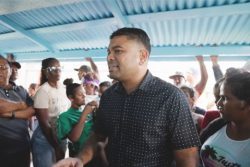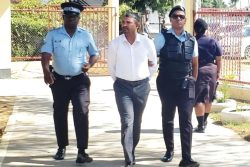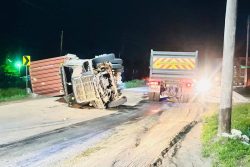 It was still stuffy when the 22 men stealthily set off for the swift-moving river, slinking among the shadows in single file and silence late one Monday night, as they sought to spot snatches of the water through the bushes in the sickly light of a slivered moon. With bare backs swollen and searing from the last set of beatings with the stinging strap, they stumbled and slipped along the shore, squeezing into the small boat tied at the side, while staring over spare shoulders, shrinking from the slightest sound that suggested sudden seizure.
It was still stuffy when the 22 men stealthily set off for the swift-moving river, slinking among the shadows in single file and silence late one Monday night, as they sought to spot snatches of the water through the bushes in the sickly light of a slivered moon. With bare backs swollen and searing from the last set of beatings with the stinging strap, they stumbled and slipped along the shore, squeezing into the small boat tied at the side, while staring over spare shoulders, shrinking from the slightest sound that suggested sudden seizure.
They would peer for pinpoints of illumination, and pant and paddle uncertainly through the darkness with calloused, sweaty hands, trying to get as far away as they could from the place of pain that had been ironically named by its first French owners for the beautiful views near the mouth of the waterway.
With its source sliding high from twin tributaries along the soaring sandstone slopes of the Makari Mountain in central Guiana, the cold, transparent channel tinted tannin travelled north for over 200 miles, widening and gradually gathering mud and pushing into the Atlantic Ocean. The murky river had won early Spanish admirers who blessed it “Rio de Mirar” for the many pleasing sights along its green banks but the Dutch would immortalise it with their lyrical version, Demerara.
For these indentured Indians in rags and sores, it must have seemed such a long time that they harboured dreams of their own, sailing from the sacred Ganges to the strange land, its river and capital city they would all shorten to “Damra,” famed for the flavourful brown sugar that bore the scent and shade of the silt-soiled Demerara.
These newest labourers would find no sweetness at their journey’s end. The tide would take them only about seven miles away to the opposite, eastern bank to another cane plantation that also carried the Dutch title of its shoreline site christened Herstelling by the previous proprietors.
According to the surviving records, the Manager of Plantation Bellevue, John Russell would testify: “That during the night of the 27th of August last (1838) twenty-two Coolies took the boat of the Estate, and crossed the River;” but “they were seen the following day at the back of the Plantation Herstelling, whither deponent immediately went for the purpose of bringing them home…”
He recalled “that they refused to return, unless one of the Interpreters, by the name of Young, was discharged from the Estate.” Russell “reasoned with them, and promised redress for any complaint they could substantiate against Young the moment they reached the Estate” but “the Coolies would not yield to his persuasions.”
The Manager was “eventually obliged to promise the instant dismissal of the Interpreter Young” and on the Thursday “the Coolies did then, without the use of any coercion whatever, voluntarily return to Bellevue.” He immediately discharged Young, who by that March, would die at Plantation Houston close by.
Described as “mulattoes” and hired as interpreters, William James Young, 21 and Charles Sharlieb, 19, accompanied the first batch of contracted workers from Calcutta travelling to British Guiana aboard the “Whitby.” The pair oversaw about 78 Indian men, mostly in their 20s and 30s and “in good health” who arrived in Demerara on May 14, 1838, assigned to Plantation Bellevue owned by Andrew Colville. Two of the designated “coolies” indentured December 29, 1837 had brought along their wives and children.
Three months later, some of the suffering Indians decided to apparently try and make a desperate break for it, heading to the only familiar conduit they knew, vaguely hoping that somehow the powerful “pani” or dynamic waters forever shaping their existence in the latest landscape, would lead them back finally to the sprawling seas, the cloudy Hooghly and the long-disappeared home, freedom and families from whence they had travelled.
Russell declared that he “never heard they said they were trying to get to Calcutta” and denied the apprehended workers were ever in Police custody, claiming that it “was the only time any of the Coolies attempted to escape, save two Brahmins, who went about three months ago as far as the Ferry at Vreed-en-Hoop.” But having been “seen with the Coolies of that Estate,” they “were sent home by the Manager; the reason they gave being that they wished to see Mr. (James) Matthews, the Attorney of the Estate, which Deponent told them they could do without going to Town.”
Swearing that he never flogged or beat the “Coolies” but may have “once or twice tapped one or two of them on the cheek with his finger,” he also lied about their issued allowances of food, clothing and wages, as stipulated in the indenture agreement, claiming deductions were only made for sick days. Hours of labour were not specified but they were required “to perform two-thirds of the tariff of labour for 7 and a half hours” daily. Each month, bilingual men like Young and Sharlieb who also served as ruthless enforcers would have made at least three and a half dollars, their supporting “mates” $3 and the labourers, $2. Weekly food allowances were supposed to include dried fish, onions and butter or oil in lieu of ghee, but the reality was even harsher with the Bellevue Indians forced to survive on just plain musty rice and lard/oil, with pepper but no onions. They were receiving the company currency of lower valued rupees issued by the shipping and merchant firm, Gillanders, Arbuthnot and Company, rather than the dollars or guilders accepted as payment in the colony. Annually, migrants were to collect at least on paper, a single precious brass cup to be shared among four men plus for each, “2 blankets; 1 chintz meyow; 2 dhooties; 1 Lascar’s cap and 1 wooden bowl” but eyewitnesses would relate the men were gaunt and nearly naked with no clothing for burials.
Later all lodged in a communal “logie” 100 feet by 24 feet, “built purposely for them, divided into one large apartment, and two small above stairs, and one large on the ground,” from the big group, an average 20 males were forced to seek medical attention weekly for festering sores produced by the tropical parasitic “chigoe/chegoe” flea; bowel complaints and “old rheumatic pains.” Some of them appeared “cheerful and contented” but it was unlikely that none of them were “sullen and morose” as the Bellevue attorney Matthew maintained in official documents.
Asked by Stipendiary Magistrate, Thomas Coleman, “Have you ever heard that they express a desire to return to India?” Matthew replied, “Some of them do; they say that this country does not agree with them, and that there are no ‘chegoes’ in their country.”
Anti-slavery activists, like the British abolitionist John Scoble would quickly take up the “Coolie cause” publicising the abuse through publications and in the media, and pressing the Government to halt the importation system. Scoble wrote, “On plantation Highbury, notwithstanding the favourable reports of the treatment of the Coolies there, the mortality has been very great, viz. seventeen males and one female, and twelve reported on the sick list, the 1st of November, 1839.”
“Coolies have repeatedly run away” from estates in British Guiana and referring to the Bellevue escape, he recounted, “upwards of twenty of them cut their way, due east, for many miles through the bush, in the hope of reaching Bengal!”
“When in the presence of those they know to be their friends, and really interested in their welfare, they give full vent to their feelings, and exhibit their real sentiments, and with tears and clasped hands, and in broken English, entreat to be sent back to their native country and to their kindred from whom they have been wantonly separated,” Scoble revealed.
Tormented by “chigoes” and its skin-burrowing larvae, ill-treated by overseers and longing to return to their homeland, the 1838 Indian indentured immigrants, particularly at the most notorious Bellevue and John Gladstone’s Vreed-en-Hoop Estates struggled to cope with the cruel demands of life – and death in British Guiana.
At Vreed-en-Hoop, similar severe thrashings, widespread abuse and persistent blackmail by a sadistic Sirdar would send “Mussalmen” Jummun, 26 and Pultun, 41, fleeing barefoot, far across the Demerara River and straight into the dense swampy backdams adjoining the Mahaica Creek and adjacent areas, along Guiana’s “chigoe” and mosquito-infested coastline, looking to retrace their journey and for an unlikely route to India.
Probably related or friends, the pair reportedly “absconded” October 11, 1838 and despite several former knowledgeable slaves being sent out to search extensively, and a reward offered by public advertisement, they were never found alive. Former slave turned paid labourer, Elizabeth Caesar would speak up at a Commission of Inquiry, “There were two Coolies who ran away and have not returned. They died in the Bush. They died on the Berbice side. Manager sent (the Estate’s Groom) Robert to look for them. Robert could not find them. He said he could not find them. I do not know whether they are dead or not.”
ID looks at the testimony of another witness, the Foreman of Plantation Vreed-en-Hoop, Will Clay who said, “There are two Coolies away from the Estate, and I have heard that they were found dead in the Lamaha Creek, but I do not know from whom I heard that. I do not know their Names regular, they have got comical Names.”









